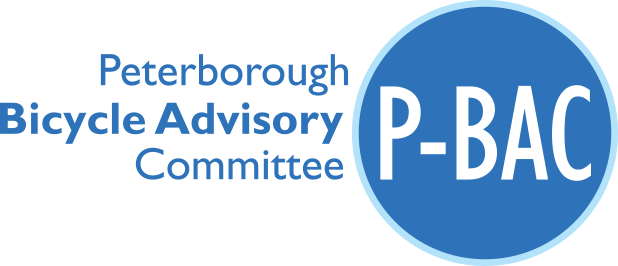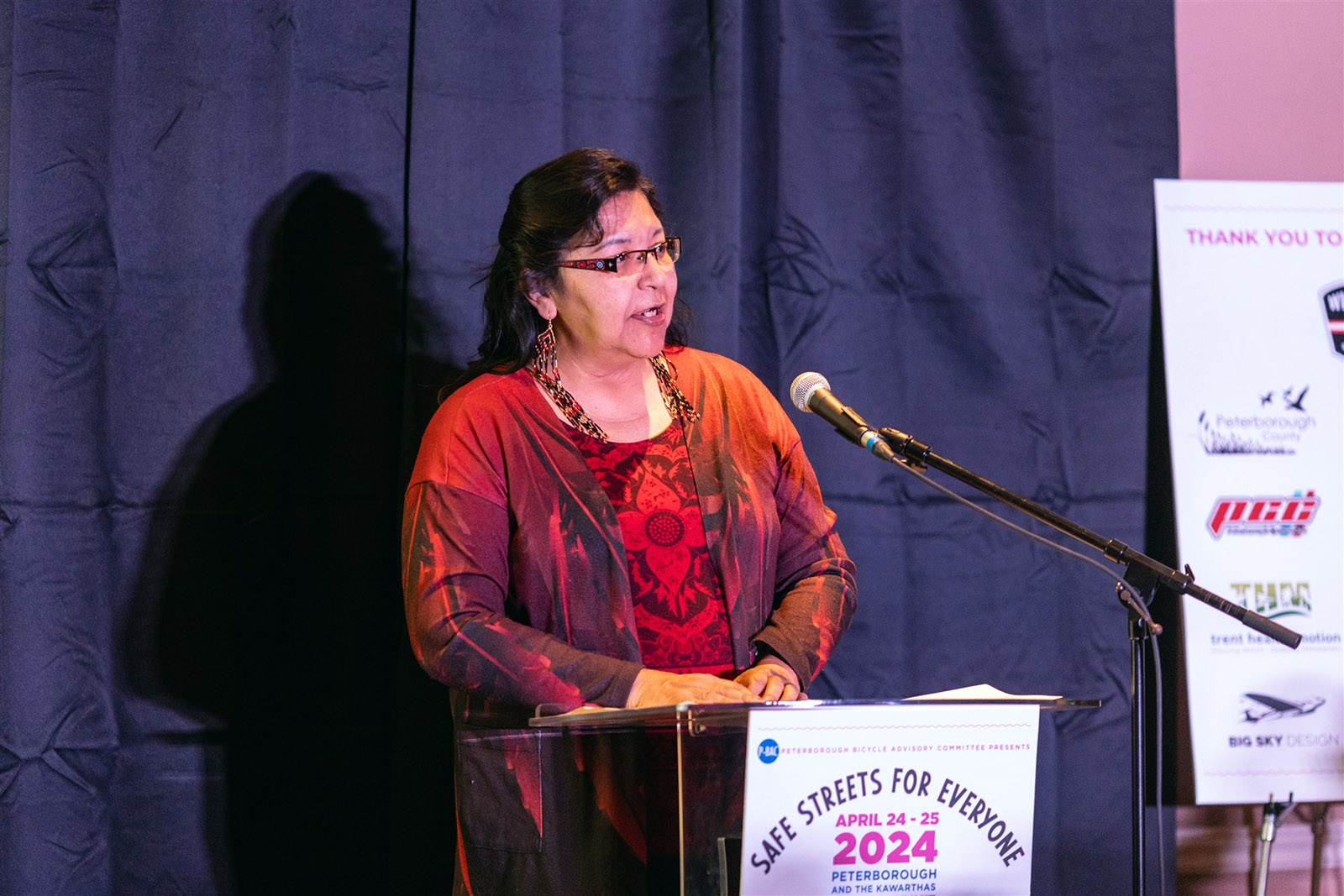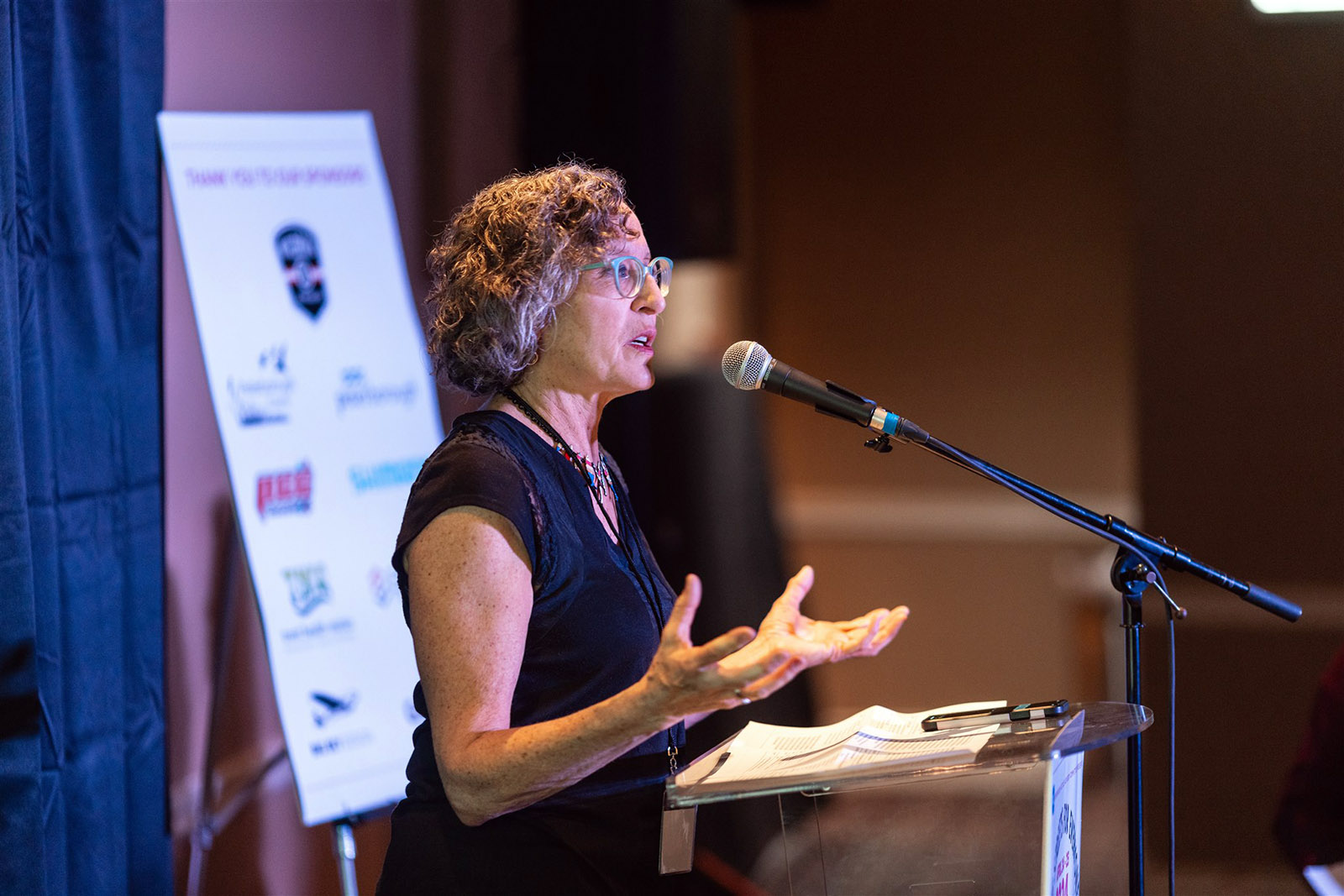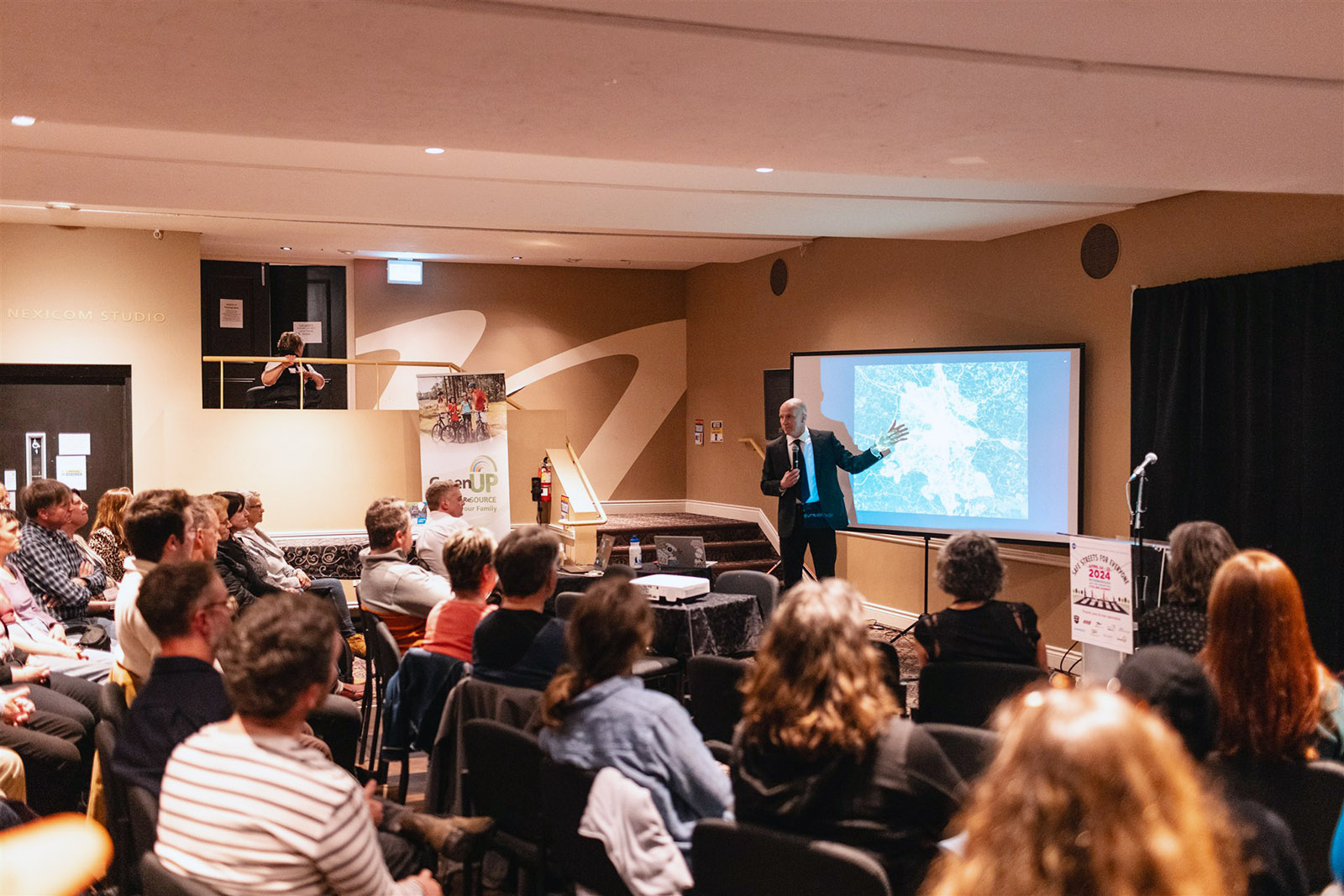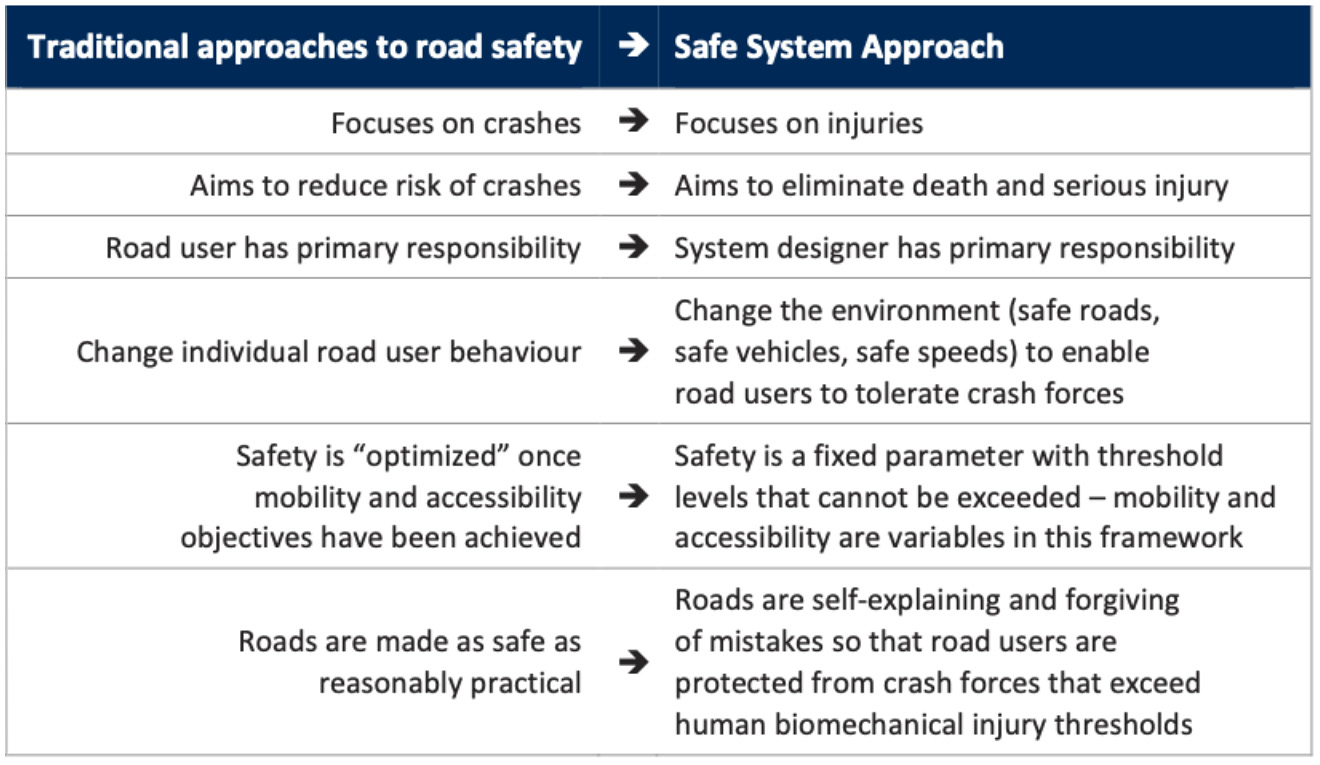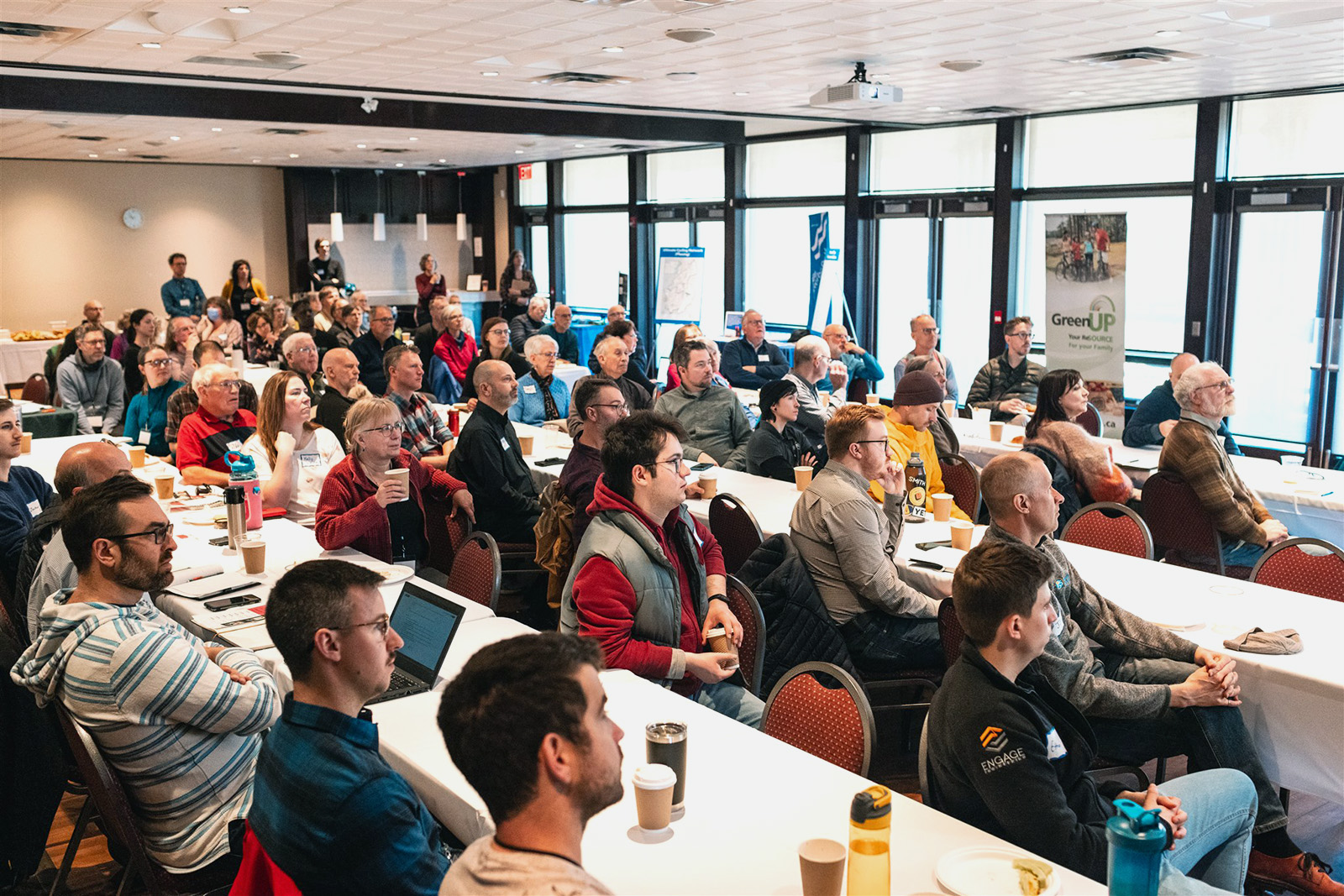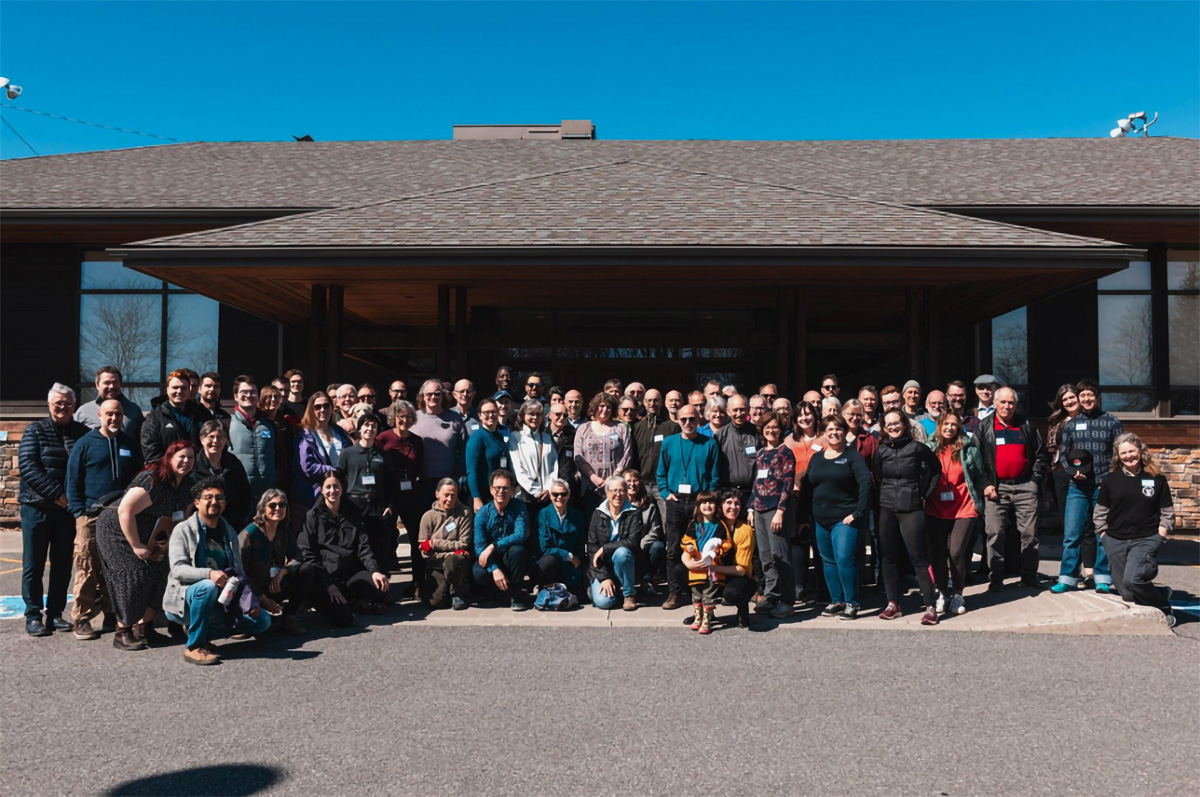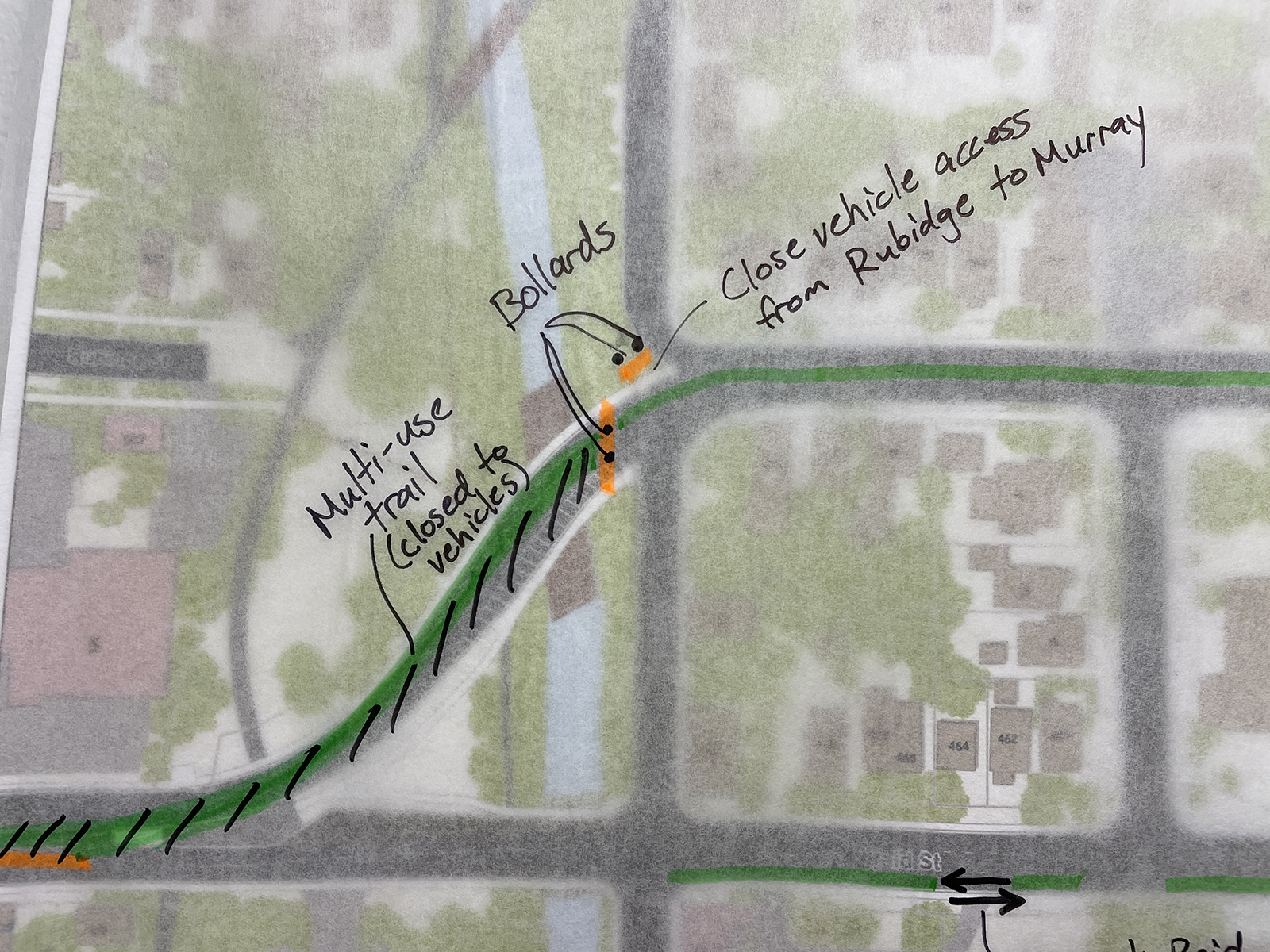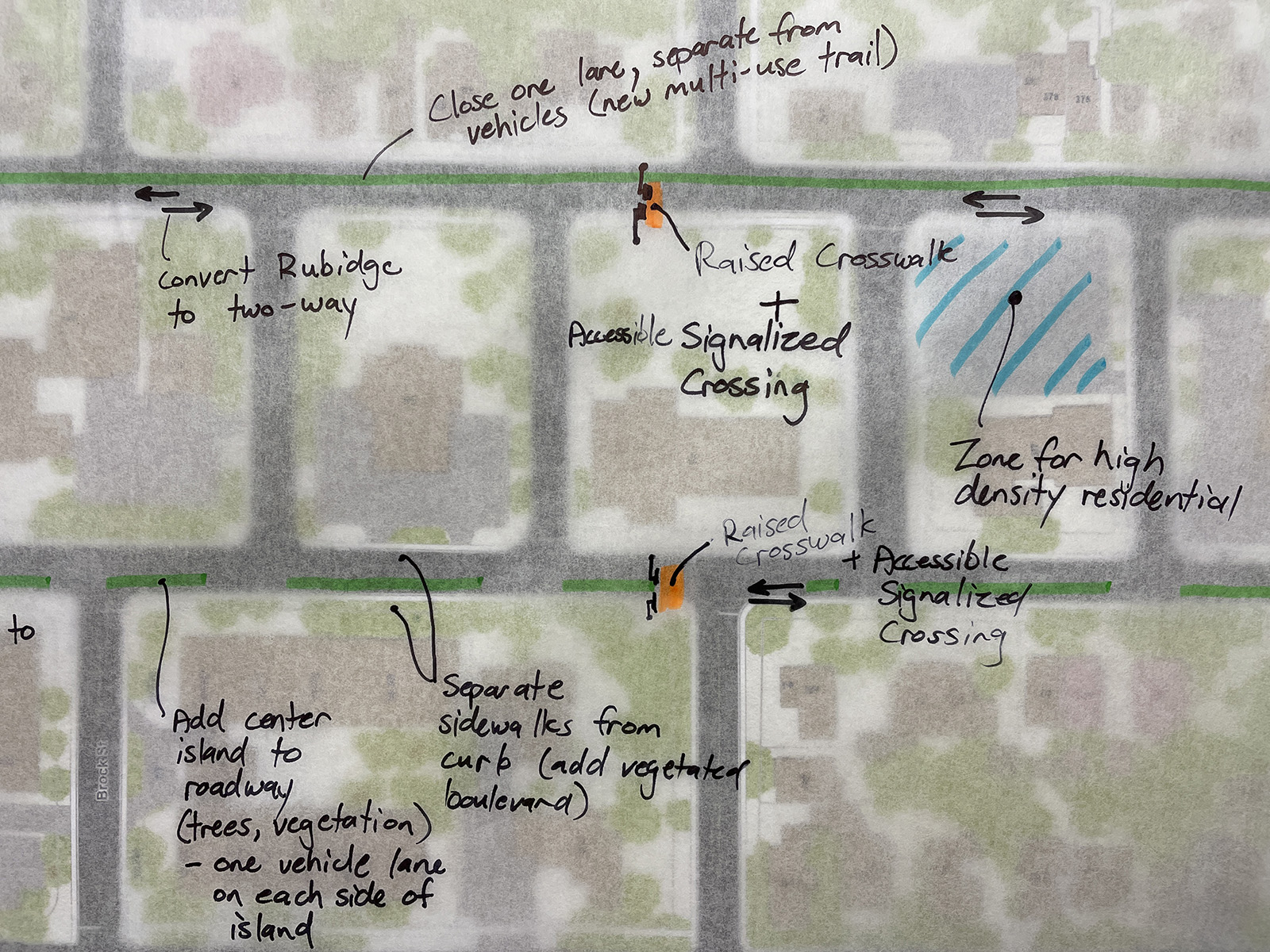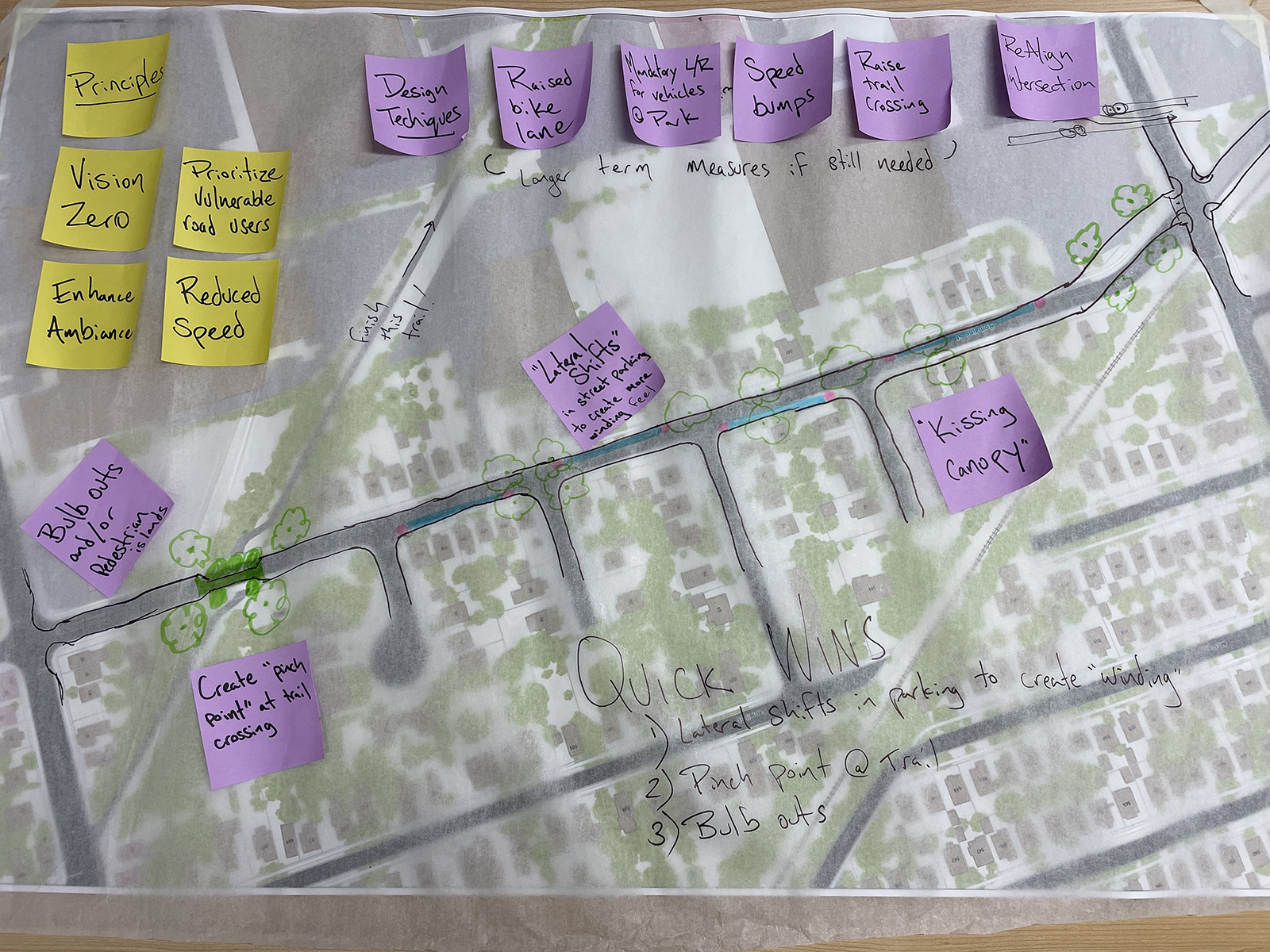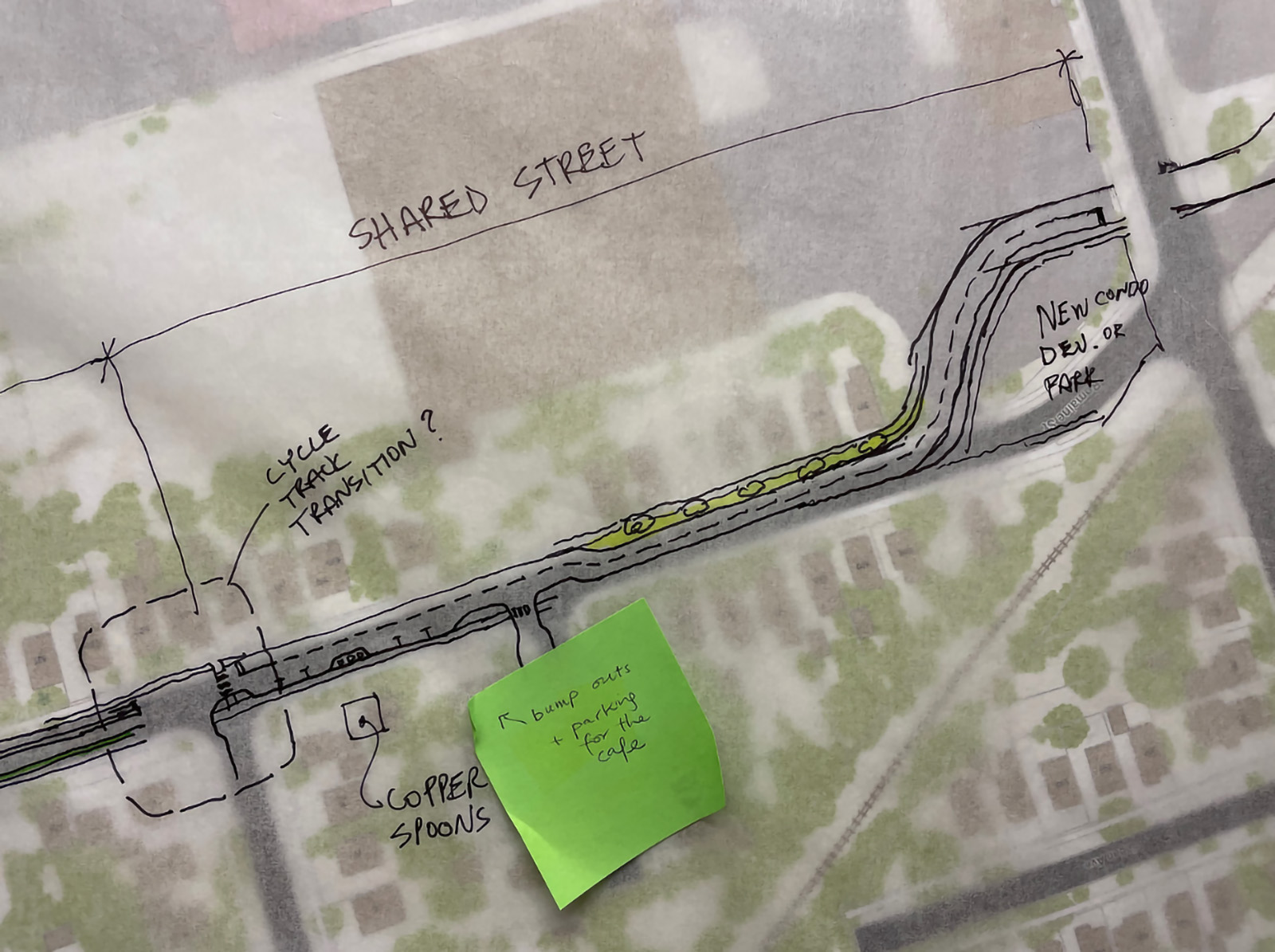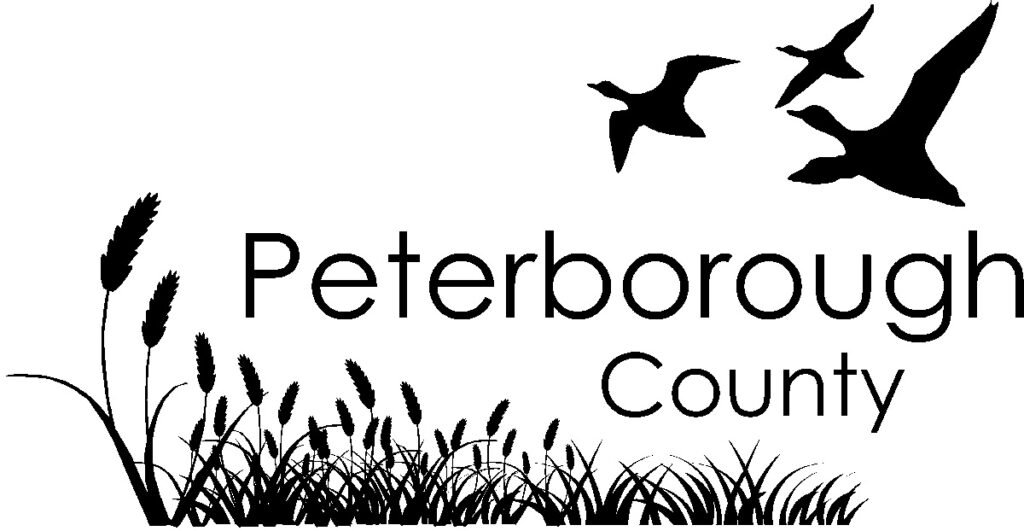Cycling Summits – 2024
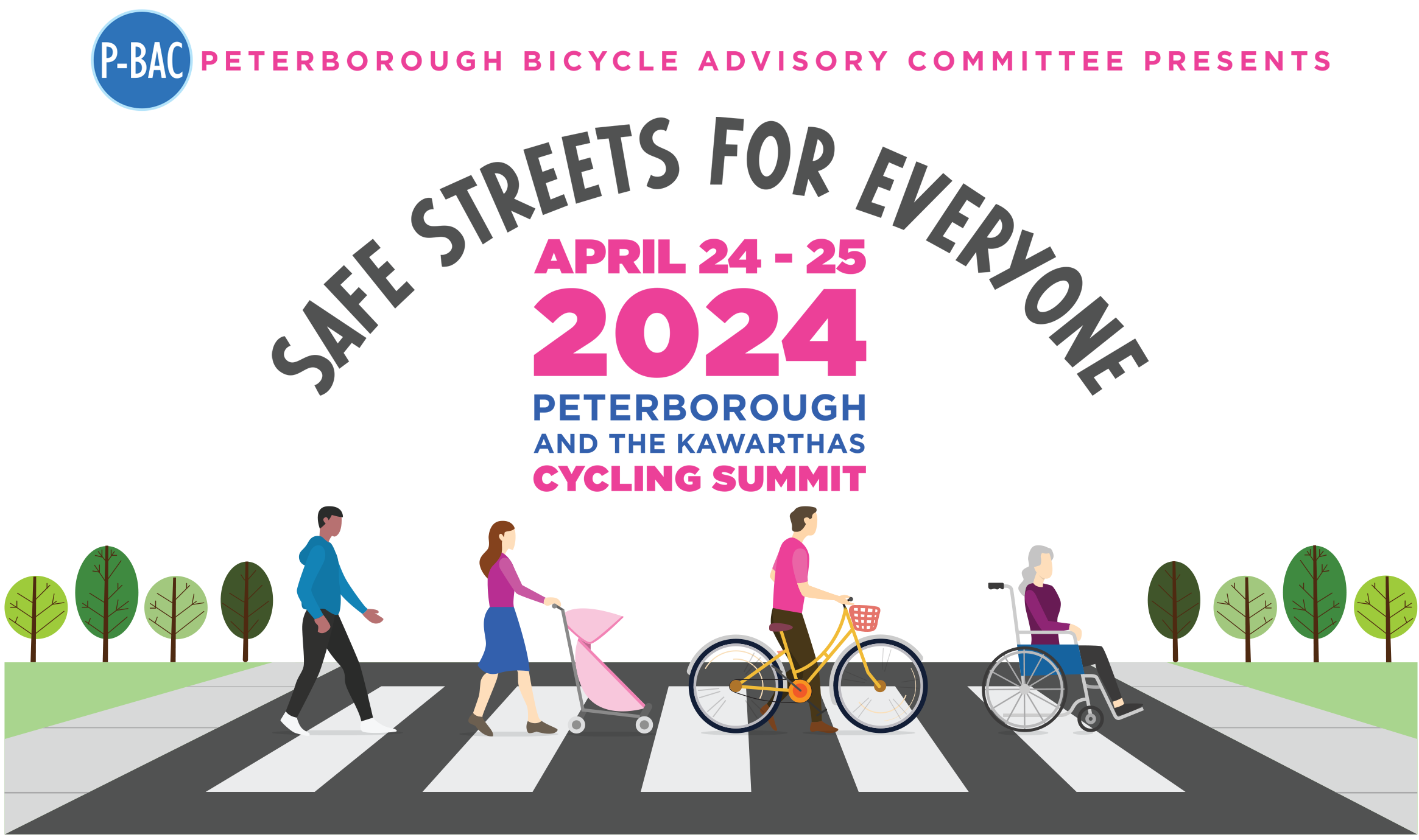
2024 Cycling Summit Reflections
2024 Cycling Summit Reflections – Part 1 of 4
Evening Keynote with Ian Lockwood
On April 24 & 25 2024, the Peterborough Bicycle Advisory Committee held a Cycling Summit with the theme Safe Streets for Everyone. For a cycling group, this may seem like an unusual theme because it is not specifically bike oriented. We chose this theme because:
-
- cyclists are vulnerable road users, meaning that, along with pedestrians and motorcyclists, they are more likely to sustain serious injuries from crashes.
- we see the merits of streets that are people-centred and want to see these benefits come to our community. Benefits include increased health, higher quality of life, draw for new business investment and better accessibility.
- we want to reduce the number of people injured on our streets. Crashes can change the course of people’s lives forever, impacting livelihoods and families.
In the early stages of planning the summit, one of our newest members, Steve McMurtry, shared a podcast episode of Strong Towns with me. The guest was Ian Lockwood, a consulting engineer known for his successful street designs. As soon as I heard the podcast, I thought, we want this guy at our Cycling Summit!
We are pleased that we were able to bring Ian Lockwood to our Cycling Summit as the keynote speaker to open our event. Ian captivated the sold out audience with a presentation showing case study after case study of street projects that have changed cities. The projects use traditional, people-oriented designs that immediately draw people in. The amazing part is that the street projects always attract private developers who invest in the area, turning cities around.
If you want to hear Ian’s keynote talk again or missed it, have a listen!
Many of the cities that Ian works with are a similar size to Peterborough, but are American cities that are quite destitute. It was surprising to see how the projects changed these cities. Ian, who originally hails from Ottawa, also does some work in Canada. What he finds is that Canadian cities are not as destitute as many of the American cities, so they are complacent, losing opportunities to improve the quality of life and the tax revenues.
What did Ian say about Peterborough?
Ian was impressed with the street layout of the majority of Peterborough, save for the newer subdivisions. With our good starting base, Ian thinks that our potential lies in:
-
- turning our one-way streets to two-way streets – this will make the streets easier for all people to use, slow down vehicle speeds and attract private investment.
- ‘stopping the (tax dollar) bleed’ of road and intersection widenings – Ian explained that many cities use traffic demand modeling to guide investments in their streets. The modeling assumes that the highest priority of streets is moving vehicles quickly and often overestimates vehicular demand. It is heavily weighted to vehicular needs without the context of what drives prosperity and quality of life. When traffic demand modeling is used as the primary tool for transportation planning, it causes investments in widenings rather than street improvements that make the city better. Ian sees, for example, that widening Chemong Road to 5 lanes is a lost opportunity to instead create a street that people would like to go to, one that would draw investment. Can you picture a revitalized area called Brookdale Village with new mixed use developments?
- adopting a two lane road approach – Ian has worked with another city bigger than Peterborough and they have adopted a two lane road policy, leading to streets that are less stressful and more enjoyable to use, while keeping transportation capital expenses relatively low. Four lane roads in an urban setting are often not desirable because they encourage speeding, lead to long red lights to accommodate pedestrians across the wide intersections associated with four lane roads and have higher rates of collisions with injuries.
Our organizing team spent many hours conversing with Ian. We learned so much and will use the knowledge shared by him when we participate in transportation project public engagements in the City and County of Peterborough.
Written by
Sue Sauve, Chair
Peterborough Bicycle Advisory Committee
Georgie Horton-Baptiste opening the Summit. Photo: Bryan Reid
Jean Greig introducing Ian Lockwood. Photo: Bryan Reid
Ian Lockwood giving his keynote address. Photo: Bryan Reid
2024 Cycling Summit Reflections – Part 2 of 4
Speakers: The Word on Safety
In real estate, they talk about location, location, location. From our two speakers on the second day of the summit, we learned that in transportation safety, the most important factors are speed, speed and speed. The images below are from the World Bank Guide for Safe Speeds: Managing Traffic Speeds to Save Lives and Improve Livability (English).
Difference in Outcomes for Pedestrians Hit by Vehicles at Different Speeds
Difference in Peripheral Vision of People Driving at Different Speeds
From Dr. Whitehead we learned that no matter where the city is located, the same features that make urban streets safer for everyone — more compact road space for cars, separated facilities for pedestrians and cyclists, slower vehicle speeds in denser business and residential areas — also make our cities more liveable and our downtown businesses more prosperous.
Valerie Smith, Director of Programs at Parachute, talked about the concept of Safe Systems Approaches, speaking to the successes and challenges faced by municipalities at different stages of Vision Zero adoption, implementation, and evaluation. She provided relevant insights from the frontlines.
After digesting the presentations from Dr. Whitehead and Ms. Smith, we are more committed than ever to advocate for safe transportation systems that benefit our community in a multitude of ways. One of the Bicycle Committee’s primary activities is commenting on transportation projects and plans the City and County are developing. We are enthusiastic to include in our submissions content on safe systems approaches that use evidence-based measures to improve our streets.
Written by
Sue Sauve, Chair
Peterborough Bicycle Advisory Committee
Summit participants. Photo: Bryan Reid
2024 Cycling Summit Reflections – Part 3 of 4
Group Walking and Cycling Tours
To ground what we learned at the summit and to provide food for thought for the design workshops, small groups headed out on bicycle and on foot to experience different parts of our City and County on the morning after Ian Lockwood’s keynote address.
Bridgenorth Ramble
County consultants, staff, Ian Lockwood and interested community members took a bus to Ward Street in Bridgenoth. With reconstruction on the horizon, the County was keen to get input into how to transform Bridgenorth’s main street into one that still serves the vehicles that pass through while giving the street more of a main street feel that is attractive and welcoming to all road users. Not surprisingly, the group found that the street does not feel comfortable for people walking and cycling along it in its current configuration. Ideas were generated that were then discussed at the afternoon design workshop.
A Neighbourhood Walk
Age-friendly Peterborough’s Jayne Culbert led a walk/roll through the neighbourhood near the McDonnel Street Community Centre to experience active transportation infrastructure from a variety of perspectives. The tour also explored the little known gateway to Parkhill Road and the west end of the City at the end of Middleton Drive.
Participants were permitted to try out a mobility scooter to see how it feels to go over bumps and curbs and navigate intersections. People were surprised at how difficult it was to get up ramps at intersections and how vulnerable they felt on Bonaccord Street with no sidewalks and rough road edges.
Walk/roll through the neighbourhood near the McDonnel Street Community Centre. Photo: Bryan Reid
Bethunescape and Its Connectors
Cycling tour of Canada’s first purpose-built bicycle-priority street. Photo: Bryan Reid
Trails of Today and Tomorrow
AAA (all-ages-and-abilities) facilities are an integral part of our City’s Ultimate Cycling Network. Photo: Bryan Reid
2024 Cycling Summit participants on Day 2. Photo: Bryan Reid
Written by
Sue Sauve, Chair
Peterborough Bicycle Advisory Committee
2024 Cycling Summit Reflections – Part 4 of 4
Design Workshops
Small community groups working together in design workshops is a great way to build community consensus on priorities for street design. At the Summit design workshops, otherwise known as charrettes, community members worked together to develop design solutions for Ward Street in Bridgenorth, the Reid-Rubidge corridors and Romaine Street as a neighbourhood greenway. There were at least two tables for each project and the results can be used to create momentum for action. The Ward Street project is an active, real-life project that the County of Peterborough is leading. The other two are projects that are not in the works, yet, but we chose them because they have potential to change the neighbourhoods they serve in a good way.
Reid and Romaine Streets
We picked the one-way sections of Reid and Romaine Streets to stretch our imaginations. Knowing that this pair of one-way streets could better serve our community, we asked summit participants their ideas. This series of images shows some of the results.
Sketch of Rubidge Street at Murray Street showing the section north of Murray Street closed to vehicles and converted to a multi-use trail.
Sketch of Reid and Rubidge Streets in the church district showing raised crosswalks, redevelopment of some of the land to high density residential housing and the conversion of Rubidge Street to a two-way street. It also shows a multi-use trail replacing a vehicle lane on Rubidge Street and vegetated boulevards providing a buffer between the sidewalks and the curb.
Romaine Street
Romaine Street is a sleepy road paralleling Lansdowne Street, providing easy access to side streets that cross Lansdowne Street. In this way, it provides a hidden gem of a route to destinations along Lansdowne. Design workshop participants came up with ideas to make Romaine Street more of an obvious cycling route, using the principles that guided the Bethune Street redevelopment. These images show some of the ideas generated.
This sketch includes post-it notes with ideas for Romaine Street including a narrowed, raised crossing for Crawford Trail users, speed humps, bulb-outs to narrow intersections, and lateral shifts in parking to create a winding, slower road.
The ideas for Romaine Street on this sketch include realigning the intersection at Monaghan Road, a new treed boulevard between the sidewalk and the street, and cycling tracks.
This image zooms in on the west end of the sketch above. It shows parking bays in the vicinity of the cafe with bulbouts to create a narrower street.
Written by
Sue Sauve, Chair
Peterborough Bicycle Advisory Committee

Registration is now open for the Peterborough and the Kawarthas Cycling Summit: Safe Streets for Everyone taking place April 24-25, 2024!
Join us for a two-day summit to share knowledge, tools and tactics that can lead towards a future where the safety of ALL road users is paramount. Through powerful keynotes, interactive design workshops, informative tours, and knowledge-sharing; our goal is to inspire actionable change in Peterborough and beyond.
As advocates for cycling, we recognize that safe streets encompass more than just bike lanes. This summit presents a unique opportunity to broaden the discourse on safe multimodal transportation.
Brief Summit Overview:
Wednesday, April 24, 7 – 9:30 pm | Showplace Performance Centre
Join us for an evening kick-off event, featuring Ian Lockwood who will share impressive stories of cities transformed through complete streets initiatives. In his presentation, Ian will talk about lessons learned and how people-centred street design has led to renewed prosperity in the cities he has worked. Grazing table, cash bar, door prize draw & networking to follow.
Thursday, April 25, 9am – 5pm | McDonnel Activity Centre
Hear from speakers who will share proven approaches to transportation safety, including tools, tactics and lessons learned from around the world, participate in a walking or biking tour, and re-imagine roads and intersections in collaborative design workshops. Breakfast & Lunch will be provided.
Bike Rentals & Billeting
Coming from out of town and need a place to stay? Want to participate in a bike tour but don’t have a bike? We have you covered! Bike rentals and billeting will be available.
Bike & Walking Tours
More Details about tours to come. Stay tuned!
Cost
The cost for both days of the summit is $15 or by donation.
Speakers
We have an incredible lineup of speakers who approach safe streets from the perspectives of public health, city planning, accessibility, engineering (and more!), who will help broaden the conversation around road safety and building a transportation network that can benefit everyone.
KEYNOTE:
IAN LOCKWOOD
Wednesday, April 24 at 7pm
Showplace Performance Centre
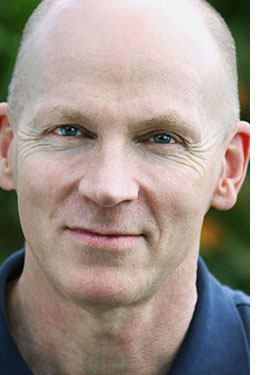 IAN LOCKWOOD P.Eng., is a Livable Transportation Engineer with Toole Design Group. Ian has Bachelor and Master Degrees in Civil Engineering and is a Harvard University Loeb Fellow, where he studied the relationship between city-making outcomes and transportation infrastructure choices. In the 1990s, Ian served as the City Transportation Planner for West Palm Beach, Florida, where he led some of the first arterial road diet and calming projects in North America.
IAN LOCKWOOD P.Eng., is a Livable Transportation Engineer with Toole Design Group. Ian has Bachelor and Master Degrees in Civil Engineering and is a Harvard University Loeb Fellow, where he studied the relationship between city-making outcomes and transportation infrastructure choices. In the 1990s, Ian served as the City Transportation Planner for West Palm Beach, Florida, where he led some of the first arterial road diet and calming projects in North America.
In 2005, Ian collaborated with Barbara McCann to define the term “complete streets,” an idea about inclusive design which has since spread widely. Ian applies the “Path-as-Place” doctrine to all his work on Main Streets, active transportation, downtowns, campuses, highway removals, and traffic reduction/evaporation projects, with a goal of increasing social and economic exchange. Currently, Ian is co-developing designs practices to help streets and open spaces become places that are highly inclusive of people with vision and mobility disabilities. In his leisure time, Ian enjoys photography, cartooning, and road cycling.
DR. SARA WHITEHEAD
Thursday, April 25, 9:30am
McDonnel St. Community Centre
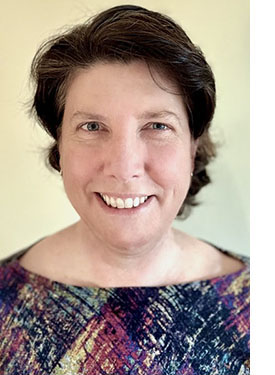 Dr. Whitehead will share experience from her road safety work in over 30 cities in Asia, Africa, and Latin America. She will describe how mobility systems affect health outcomes, from crashes to air pollution and physical activity. Examples of how these low-resource cities around the world are creatively addressing safer and more sustainable mobility will be presented and lessons learned applied back to Peterborough.
Dr. Whitehead will share experience from her road safety work in over 30 cities in Asia, Africa, and Latin America. She will describe how mobility systems affect health outcomes, from crashes to air pollution and physical activity. Examples of how these low-resource cities around the world are creatively addressing safer and more sustainable mobility will be presented and lessons learned applied back to Peterborough.
Bio:
DR. SARA WHITEHEAD is a public health physician with over 25 years’ experience at local, national, and international health institutions. As a consultant to Vital Strategies (New York) since 2015, she leads a team strengthening road traffic injury surveillance systems in 30 cities in Asia, Africa, and Latin America, supporting road injury prevention interventions through the Bloomberg Philanthropies Initiative for Global Road Safety. She helps city governments get access to better data, well-analyzed, to inform their interventions for safer and more sustainable mobility.
Sara previously worked for the US Centers for Disease Control and Prevention for 14 years as a medical epidemiologist, most of that time in CDC’s Bangkok office. She was a Medical Officer of Health with northern First Nation communities in Ontario and Saskatchewan before moving to the CDC. She obtained her MD at McMaster University, an MPH at Johns Hopkins University, is certified in both Family Medicine and Public Health/Preventive Medicine, and has an appointment as Assistant Professor at Queens University Faculty of Health Sciences.
Outside of work, Sara enjoys paddling, hiking, and experimenting in the kitchen.
VALERIE SMITH
Thursday, April 25 at 1PM
McDonnel St. Community Centre
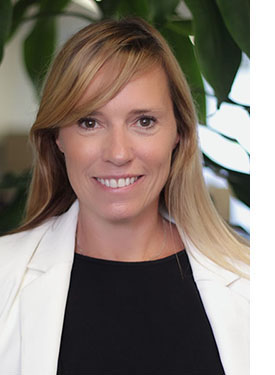 VALERIE SMITH’S role as Director of Programs at Parachute is focused on road safety and safe mobility. At Parachute she oversees all of Parachute’s road safety campaigns. She also oversees the mobilization of Parachute’s Vision Zero (VZ) network, with nearly 1,000 stakeholders across Canada. Through her role at Parachute, she has worked with transportation representatives and partners at federal, provincial, territorial and municipal jurisdictions. She led a Parachute Canada team in developing cutting-edge VZ published resources such as Change for Good Roads – An intersectoral approach to urban road safety, and Parachute Vision Zero: Canadian Landscape 3.0 that profiles jurisdictions implementing or considering Vision Zero.
VALERIE SMITH’S role as Director of Programs at Parachute is focused on road safety and safe mobility. At Parachute she oversees all of Parachute’s road safety campaigns. She also oversees the mobilization of Parachute’s Vision Zero (VZ) network, with nearly 1,000 stakeholders across Canada. Through her role at Parachute, she has worked with transportation representatives and partners at federal, provincial, territorial and municipal jurisdictions. She led a Parachute Canada team in developing cutting-edge VZ published resources such as Change for Good Roads – An intersectoral approach to urban road safety, and Parachute Vision Zero: Canadian Landscape 3.0 that profiles jurisdictions implementing or considering Vision Zero.
Val is taking a leadership role for Parachute in promoting the Global Decade of Action for Road Safety (2021-2030) in Canada in collaboration with CARSP and other national groups. She also is the President of the Canadian Association of Road Safety Professionals.
As a spokesperson at Parachute, she participates regularly in national and local interviews and presents at national, provincial, and international road safety conferences. In 2022, she received Ontario’s Ministry of Transportation Road Safety Achievement Award, recognizing outstanding contributions of individuals and organizations.

